 Maintaining machinery now saves time and money later
Maintaining machinery now saves time and money later
BY GARY JAMES
What one action do all mattress producers need to take to keep their mattress manufacturing equipment in good working order? Implement a robust program of preventive maintenance, leading machinery suppliers say. A well-designed program includes inspecting equipment regularly, replacing worn parts before problems occur and conducting any necessary service, such as lubrication, sharpening or re-calibration, on a consistent, timely basis.
The benefits of such a proactive approach are multifold, equipment suppliers say. Maintenance helps keep machinery in good working order for current production while also heading off problems—and potential breakages—that may occur down the road.
“Preventive maintenance should be the motto of all factories,” says Costas Georgallis, founder and managing director of Amelco Industries Ltd. in Nicosia, Cyprus, whose line includes roll-pack, baling, frame, mattress-packing and pillow-filling machines. “Producers should always follow the equipment manufacturer’s instructions and not wait until a breakdown to repair and maintain their machines.”
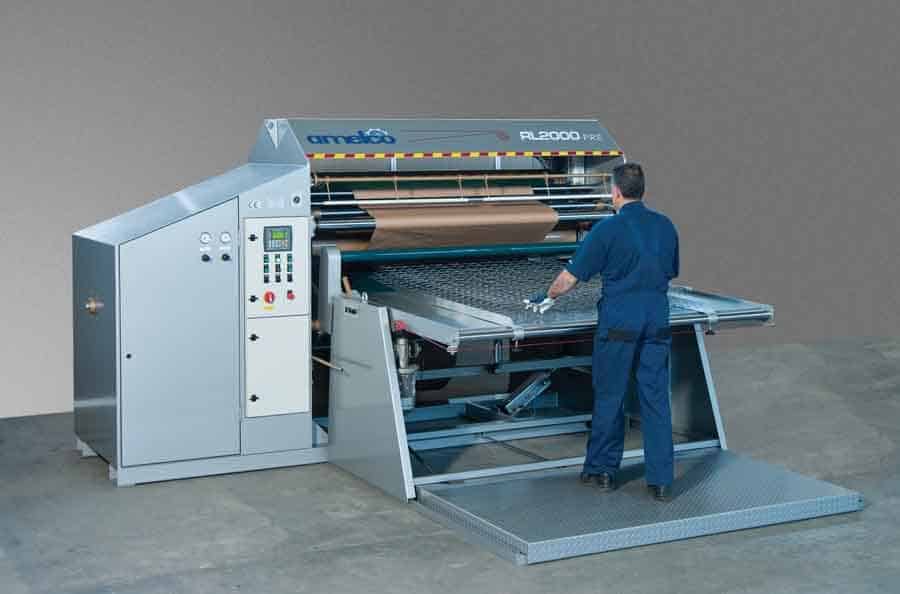
An important reminder Nicosia, Cyprus-based Amelco Industries Ltd.’s RL2000 roll-packing machine features a programmable logic controller that issues a notice when the time comes for scheduled service.
The cost of unplanned maintenance includes decreased production, higher costs for parts and shipping, plus lost time responding to emergencies and diagnosing faults while machines aren’t working, Georgallis says.
Regular cleaning and oiling, as well as “common engineering sense, such as watching the tolerances on the machine,” are the cornerstones of a successful preventive maintenance program, he says. In addition, each operator must be able to maintain the machine—and be trained to perform minor repairs if a need arises.
Diligence pays off
Atlanta Attachment Co. Inc., a global supplier and provider of solutions for the sewn products and aviation industries, stresses the importance of regular maintenance, says William Richey, vice president of customer service. The company’s motto is “Sudden Service”—a promise to consistently deliver quality products and top-notch service.
“The key to maximizing the efficiency and lifespan of any mechanical workstation is not only implementing operations according to the machine’s designed function, but also having a periodic schedule of manufacturer-defined proper, preventive maintenance,” Richey says. To support its customers, Atlanta Attachment’s Technical Service Group makes maintenance visits when requested and offers professional training in sewing methods.
“They are versed in mechanical, electrical and pneumatic operating systems, providing expert on-site information,” Richey says. “They also are skilled at making any adjustments and, just as importantly, in training others how to make the adjustment and why the adjustment is necessary.”
A well-maintained piece of equipment will produce a “continuous stream of products over a long period of time,” Richey says. Equipment that’s not maintained properly or that’s over-extended may churn out above-normal production numbers for a short run, he says, “but it will be followed by intervals of downtime due to the need for emergency maintenance.”
Start with the fundamentals
Proper maintenance begins with daily checks of a machine’s mechanical systems and key components, such as drive belts, as well as regular cleaning and lubrication. For example, tape-edge sewing heads should be oiled at the end of each day’s production and as needed during the day, says Bob Ferry, vice president of James Cash Machine Co. in Louisville, Kentucky, which supplies tape-edge machines, box-spring taping machines, border sergers, flangers and build-up tables to the mattress industry.
“When machinery problems arise—no matter how small—make repairs as soon as possible,” Ferry says. “Service intervals for tasks such as clutch adjustment, belt replacement, etc., will vary, depending on the machine usage. We offer technical support to help diagnose problems and find repair solutions.”
Ferry says producers should keep an inventory of “consumable parts” for their machinery “so repairs can be made quickly with minimal downtime.”
Daily cleaning also goes a long way toward keeping machines in good working order. Operators should get in the habit of wiping off excess oil and grease and removing dust, dirt and debris, all of which can build up and interfere with performance. A clean machine also is easier to inspect and service.
“I feel like places that regularly clean their machinery have more respect for the expensive and complicated nature of the machine—and a respected machine generally gets better maintenance,” says Tommy Johnson, mechanical engineer and principal with D.R. Cash Inc. in Louisville, Kentucky.
In addition to keeping the machine clean, Johnson says that anyone who interacts with the equipment needs to read and comply with the guidance in the instruction manual.
“My manuals will tell you most everything you need to know about the machine, including how to install, operate, adjust and maintain it properly and safely,” Johnson says. “A well-informed operator or maintenance provider has a better chance of knowing when something about the machine doesn’t seem right. Being able to detect abnormal machine performance quickly also can allow you to catch a minor problem before it turns into a major one.”
Producing heat sealers, tape-edge machines and mattress-filling machines at its own facility, D.R. Cash designs its equipment so it requires as little maintenance as possible. It also tries to make the machinery easy to work on—with accessible bolts and screws—so that maintenance “is not an all-day or a complicated affair,” Johnson says.
Service intervals depend on the machine and how often it is used, but general maintenance, such as monitoring safety devices, cleaning and checking screw connections, “should be done on a daily basis,” Johnson says. “Other things, like applying grease to sliding parts, should be done weekly or monthly.”
As a small, hands-on supplier, when problems do occur, “you’re going to be talking to me or someone else at D.R. Cash who is personally familiar with your piece of equipment,” Johnson says. The company also incorporates a process controller on its sealers to help with diagnosis, “but it’s nowhere near the complicated nature of the software running quilters and spring machines offered by other companies.”
Still, down the road, Johnson sees advances in technology enabling suppliers of all sizes to make “smarter” machinery that can diagnose its own problems. “But I think for the foreseeable future it’s going to take well-informed, proactive personnel to keep all this machinery running well.”
Training for success
Establishing a thorough, ongoing training program for mechanics, technicians and operators is a must for maintaining reliable machines, suppliers agree.
“It is not just the maintenance mechanic who is responsible for keeping a machine running,” says Roy Schlegel, president of Edgewater Machine Co. in College Point, New York, whose line includes lock-stitch, embroidery and tack-and-jump machines. “It’s important that an operator be know-ledgeable about the machine he or she is running so they can communicate with the maintenance mechanic about the machine before a failure causes complete downtime for the machine or, at the very least, causes an inferior product to be produced.”
Operators are in a prime position to recognize when a machine may be heading for trouble. “A good indication of a problem is when an operator hears a different sound or vibration from a machine,” Schlegel says.
An inspection of the finished product for flaws often can tell the operator or mechanic that something isn’t right. “It might point to a minor adjustment needed, or it might be telling you that something needs attention before the problem gets worse,” Schlegel says.
An operator must communicate to the technician any abnormalities with the machinery as soon as possible. “Preventing downtime is key to keeping profits up for a company,” Schlegel says. “When a machine is down, it can affect an entire assembly line’s production.”
New service twists
As machinery suppliers introduce new equipment, service requirements for many types of machines are becoming simpler—and service intervals are growing longer.
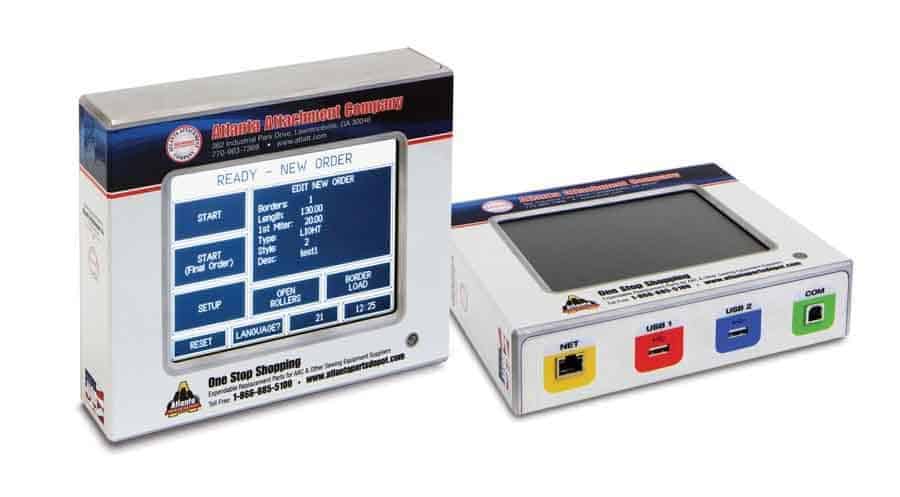
A leap forward Atlanta Attachment Co. Inc., with headquarters in Lawrenceville, Georgia, says its new Serial Bus Control System represents a ‘quantum change’ for sewn products. Using only four wires, the system is self-diagnostic and offers solutions via interactive display if there are problems.
For example, Atlanta Attachment’s latest automated sewing equipment features a new Serial Bus Control System that the company describes as a “quantum change” for the sewn products industry. Using only four wires, the system is self-diagnostic and offers solutions via an interactive display if there are problems.
“An operator using a touch-screen control panel manages this rugged, uncomplicated system,” Richey says. “Designed to international standards, this multilingual, easy-to-operate interface allows parameters to be saved, gives technicians access with password protection and offers a built-in production performance monitor that can be networked to a central computer.”
Atlanta Attachment backs up the Serial Bus Control System with an unconditional three-year warranty on all the electrical components.
Amelco touts the latest generation of its roll-packing machine as practically maintenance-free, except for regular cleaning and oiling. “No spare parts are needed for many years,” Georgallis says. “Normally, the parts we are asked to replace are damaged as a result of an operator’s error or lack of cleaning and oiling.”
A handful of points on the roll-packing machine need to be oiled every day, and the bearings and gearbox should be checked every six months, according to the company. The hydraulic oil should be changed once every two years—the machine’s programmable logic controller issues a reminder when that time comes. “The PLCs incorporated into our machines prevent, to a certain extent, the operators’ mistakes, and they help avoid possible damage to the machines,” Georgallis says.
Amelco’s frame-forming machine also requires very little maintenance. Gearboxes are sealed for life. The machine does have a few points that require daily lubrication, as well as a variety of “perishable” parts that need to be replaced after two or three years under normal working conditions. Cutters, feeding wheels and brakes need to be monitored for wear. But even the cutters are made to last, Georgallis says. “They have four sides and each side has three working positions. With a good schedule using all 12 cutting points, the cutters should last for many years.”
Smoother sailing
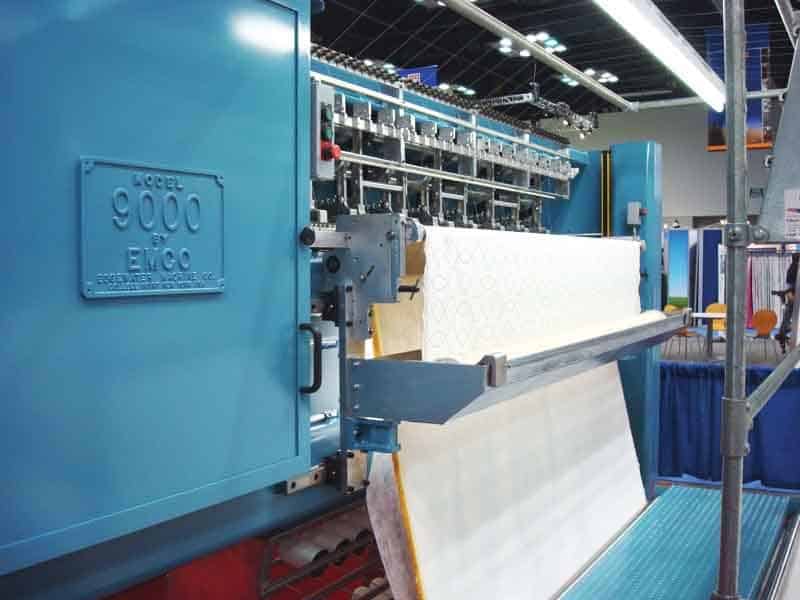
Maintenance-minded The new EMCO 9000 series chain-stitch quilter from College Point, New York-based Edgewater Machine Co. uses sealed ball bearings that minimize the need for lubrication. Software signals when preventive maintenance is needed.
Edgewater’s older, traditional machines required daily oiling and weekly greasing of key components to prevent premature wear, but its newer EMCO 9000 series chain-stitch quilting machines have been engineered using sealed ball bearings in every moving part to minimize maintenance requirements.
“We removed all friction-causing reciprocal motion of steel rubbing against sleeve bearings,” Schlegel says. “We removed cams and springs and replaced them with computer-controlled motors. With all oiling points eliminated, our machine is 95% maintenance free. The only requirement is keeping the machine clean and greasing the ball bearings once a month.”
In addition, Edgewater’s latest equipment comes with software to track machine usage and signals when preventive maintenance is due. “This eliminates the guesswork of when service is required for the machine and helps to prevent downtime,” Schlegel says.
The new HTX slitter from ESCO (Edge-Sweets Co.), which is used to slit a variety of polyurethane foams, also requires less maintenance to yield higher levels of productivity, says Rick Hungerford Jr., president of the Grand Rapids, Michigan-based company, which also produces lock-stitch, embroidery and chain-stitch machines. The HTX’s enhanced features include a new wheel tracking system that uses a simple, yet sturdy bearing setup for easier tracking adjustments; a new sharpening system that is more effective at maintaining a proper blade bevel; and a new automated blade glide system that keeps operators away from sharp edges while minimizing blade friction and extending blade life. The blade glide system also allows users to apply a fine, atomized mist of silicone on just the blade guide so silicone doesn’t get into places it shouldn’t, such as blade wheels.
The HTX ships with a computer interface that facilitates remote debugging and support from anywhere in the world via an Internet connection. “Additionally, the new operator interfaces are touch-screen driven with iPad-like interfaces that make the machinery easier to learn by operators, reducing training time and operator error,” Hungerford says.
Tools for diagnosis
To help its customers minimize production interruptions, Bäumer introduced an industrial broadband virtual private network router in 2013 called Bäumer-Connect, or B-CON. The system offers rapid, reliable remote diagnostics for machines worldwide: Off-site service technicians have secure access to the relevant machine or plant, enabling them to perform maintenance or make a diagnosis from any location via a computer, smartphone or tablet, according to the company.

Keeping in contact To help manufacturers minimize production interruptions, Bäumer introduced an industrial broadband virtual private network router called Bäumer-Connect. Also known as B-CON, the system offers rapid, reliable remote diagnostics for machines worldwide, according to the company, which has U.S. headquarters in Towaco, New Jersey.
“Our B-CON unit, which is installed in each machine, allows us to help diagnose any issues, often without even needing a technician to visit,” says Terry Borchard, sales and key account manager for Bäumer of America in Towaco, New Jersey, which specializes in cutting lines and machines. “The B-CON also has the ability to send SMS (short message service) messages to designated employees or Bäumer technicians to update them on the general health of the controls and how the drives are doing, enabling them to maintain or adjust the machine before it is too late.” Alarms can be configured so that specified personnel are notified immediately when an error occurs. Bäumer’s help desk provides advice and insights into many issues over the phone from its offices in the United States and in Freudenberg, Germany, where it is headquartered.
Bäumer machines are built to last a long time, Borchard says, but—as with all machines—maintenance is a must. “When a machine is new, just like a car, less time is needed to maintain its parts, but the older the machine becomes, the more time is needed to maintain its accuracy,” he says.
Borchard suggests operators follow the daily/weekly/monthly schedules recommended for each individual machine and that a Bäumer-trained service technician visit a mattress maker’s factory annually.
Small problems can add up
While most bedding manufacturers do a good job of keeping up when it comes to major maintenance, small malfunctions, such as air leaks, sometimes go unnoticed. And small problems over a period of time can have a big impact on costs.
“When an air leak is present or an insufficient air supply is connected to the workstation, you not only lose pressure, but many times an issue with the equipment is misdiagnosed because the air volume supplied to the workstation is lacking,” says Atlanta Attachment’s Richey. “When overlooked or misunderstood, the situation therefore is deemed a mechanical issue. We have seen incidents in plants where the drop in air pressure from idle to running would be 20 psi, which is a 25% reduction in the speed or production of the workstation.” To avoid such problems, Richey recommends that operators locate and repair air leaks as soon as they develop.
Other items that mattress manufacturers often forget to check until it’s too late are motors and drives. These parts can be especially hard to replace and cause major downtime if not easily sourced.
To help producers avoid such problems, ESCO narrows the selection of motors and drives for its machines to focus on common and readily available platforms. Spare backups of “critical motors and drives are nice to have on hand but are a luxury most do not have budgets for,” Hungerford says. He advises producers to check in advance with machinery suppliers to make sure that any motors and drives they might need are readily available.
Regardless of the size of the plant or the equipment being used, having a consistent program of preventive maintenance in place helps reduce machine failures and minimize the impact when problems do occur, equipment suppliers agree. Preventive maintenance also costs less than reactive, after-the-problem-occurs repairs.
“When maintenance is planned, the machinery can be shut down to coincide with production downtime,” says Amelco’s Georgallis. “Prior to the shutdown, any required parts, supplies and personnel can be gathered to minimize the time taken for repair. All of these measures decrease the total cost of maintenance.” ■
GSG strives to make maintenance easier
When it comes to preventive maintenance of bedding machinery, “these are different days,” says Paul Block, vice president of sales strategy and product planning for Leggett & Platt Inc.’s Global Systems Group in Carthage, Missouri. GSG’s products include Gribetz quilters, Porter sewing machines and Gateway tape-edge machines.
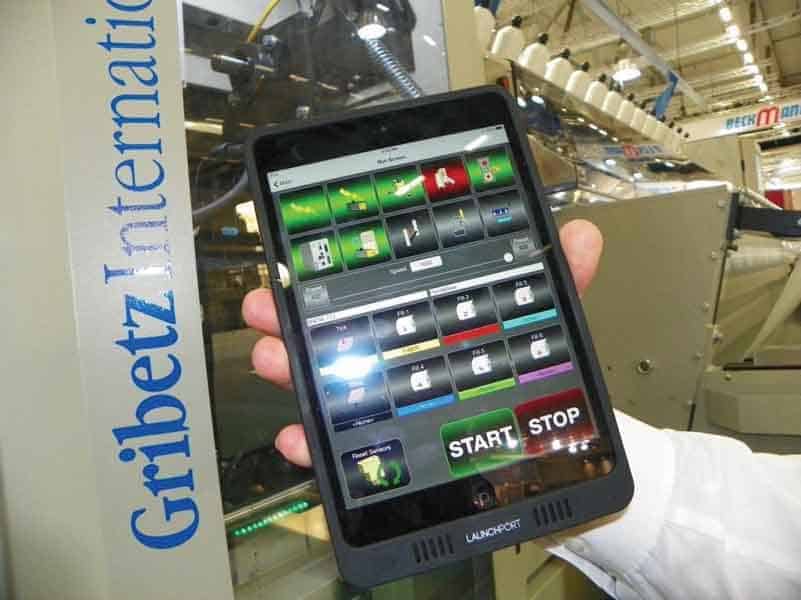
Direct connection The new remote diagnostic system offered on Global Systems Group’s Gribetz machinery includes a self-charging portable tablet interface that allows users to show service personnel issues they are having via online video chat software. The portable tablet contains all the machine manuals, displays technical statistics and allows the operator to control machine functions remotely. Global Systems Group, a division of Leggett & Platt Inc., is based in Carthage, Missouri.
“Many of our customers all around the world are cutting maintenance staff and trying to do more with less,” Block says. “Companies are not always staying with experienced technicians, and producers still require their machinery to be more productive and flexible than ever before. Downtime is unacceptable, and our response to their problems is more crucial than ever.”
The best advice Block says he can give to bedding producers who want to keep machinery in optimal working order is to use manufacturer-specified parts and to follow preventive maintenance procedures on all machinery. Each and every machine has different maintenance requirements, depending on the speed it runs and the type and volume of product it makes.
“Very general rules such as ‘change the oil every six months’ don’t cut it anymore,” he says, explaining that GSG now builds machines with built-in preventive maintenance systems that monitor key components of the machine. “They don’t just calculate a run time or a group of hours and give you the preventative maintenance procedure. They calculate the load the machine is absorbing. They keep track of the machine’s particular maintenance schedule and keep a log of who did what and when. They tell you exactly what should be done and give you diagrams as to what to do. They keep it simple and obvious. This is what is required in today’s specialized and highly productive world.”
Any machine is only as good as the sum of its parts, Block adds, so he recommends that mattress producers only use manufacturer-specified components.
“The highly technological machines used in mattress manufacturing are designed to operate with specific parts made to exacting standards. Using non-OEM specified parts puts the overall integrity of the machine at risk,” he says. “The optimal efficiency of the machine may be jeopardized and the substituted part may also lead to premature failure of other connected parts.”
If production problems do occur, GSG provides tools to help manufacturers deal with them, Block says.
“We have an online service site through Gribetz for sending in service call forms. This way, a factory technician can send information on the issue that they are dealing with to Gribetz and get a call back or an email with solutions in a very quick time frame,” he says.
GSG also uses a FastTrack software program that traces and records every service issue and how it was handled. Through a database of service records, the company has developed a series of probable solutions for the most common re-occurring issues to speed up diagnostics and service. In addition, the company has a large staff of experienced, skilled customer service technicians throughout the world. “They are armed with this huge database of solutions, diagrams, schematics, maintenance procedures and historical data to give customers the best possible service that can be offered,” Block says.
At Interzum Cologne in May, GSG demonstrated a new preventative maintenance software program for its Gribetz V16 and new Paragon quilters that monitors machine performance in real time. The system tracks the timing of maintenance and gives running graphs that signal personnel as to when and how to perform all key preventive maintenance procedures. As each task is performed, the software logs information on the nature of the service and other key variables.
“We can greatly impact maintenance by using technology to make the user’s job easier and simpler,” Block says. “Almost all our automated machines now have the manuals and troubleshooting guides built into the controls on the machine. They can also sign up to see parts lists online and order replacements at the touch of a button. They can send in maintenance questions and issues online to service personnel.”
For factories with Wi-Fi access, GSG’s new controls have a remote diagnostic program that allows Gribetz service technicians and engineers direct access to the operating screen of the quilt machine to better understand any issues the customer is experiencing.
“This firsthand access makes troubleshooting a much quicker and more precise exercise,” Block says. ■
Choosing replacement parts requires a bedding maker’s full attention
Mattress manufacturers need more than established routines for daily, weekly and monthly maintenance of all the equipment on their plant floors to keep production running smoothly. For best results, they also need a stock of key parts on-site—or within quick access—so that blades, needles and other vital, high-use equipment can be replaced when needed with minimal downtime.
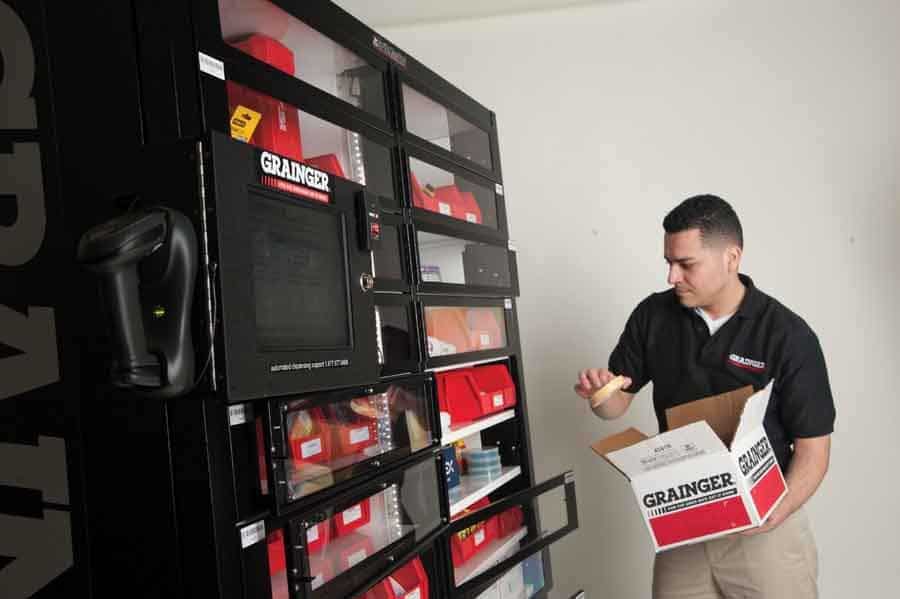
Keeping it in stock Beverly, Massachusetts-based Jumpsource has teamed with maintenance, repair and operating products giant W.W. Grainger in Lake Forest, Illinois, to offer the KeepStock inventory management system to the bedding industry. The program includes in-plant vending machines for easy replenishment of frequently used parts.
In 2004, Atlanta Attachment Co. Inc. in Lawrenceville, Georgia, expanded the services it offers bedding producers with the launch of Atlanta Parts Depot. Today, Atlanta Parts Depot inventories a complete line of OEM and generic replacement parts for Atlanta Attachment equipment, as well as other leading sewing equipment manufacturers. Domestic and international support for questions about parts is provided by multilingual customer service agents. The company also offers on-site stock-management systems.
“Since beginning business in 1969, AAC has participated in the design features related to many of the original parts, which are sold as generics today,” says Eric Iverson, sales manager of Atlanta Parts Depot. In making a decision about whether to buy an OEM or generic part, he recommends “going to the source”—the original equipment manufacturer—when possible.
“Utilize your resources and ask questions,” Iverson says. “Price is not always the sole benefit upon which to base a long-term decision. Is a generic appropriate for this application? Because we field test every design before releasing it to the market and, as an added benefit to quality control, we solicit and listen to feedback from our valuable customer base. We know the answers to these types of questions.”
Atlanta Parts Depot’s stock management system offers mattress makers an easy solution for parts replenishment. The core of the system is a series of in-plant storage cabinets that dispense parts to authorized personnel, automatically review inventory levels of key parts daily and place electronic purchase orders whenever stock levels drop to predetermined levels.
According to Iverson, the system enables producers to reduce the cost of parts management by streamlining their sourcing structure, better managing stock redundancy and ensuring that key parts are available when needed. The system also provides producers with the ability to network parts inventory across multiple locations.
Quality counts
Ensuring quick access to needed parts is a critical part of any effective equipment maintenance program. But the quality of parts is an equally important—though oft-overlooked—element, says Sam Porter, vice president of operations for Jumpsource, a metal components supplier based in Beverly, Massachusetts.
“In the bedding industry, there is a lot of inconsistency with parts quality,” he says. “The quality of a certain part can vary greatly from supplier to supplier. Many companies sell loopers, but are you buying genuine OEM-quality loopers or a lower quality copy?”
Most loopers sold globally are of generic quality—made to fit but not necessarily to perform, according to Porter. “The quality of the materials used usually isn’t up to par, which can significantly limit the function and lifespan of the part,” he says. “A generic part may cost less money upfront, but it increases your risk of downtime by more than 50%, potentially costing a plant thousands of dollars.”
Jumpsource describes itself as the world’s largest manufacturer of custom bedding and textile parts. The company offers its own brand of bedding parts called Original Quality, produced at its own plants in China that are guaranteed to meet or exceed the quality standards of OEM parts. Currently, Jumpsource supplies more than 6,500 custom and critical parts for all major brands in the bedding industry.
“We sell parts to the bedding industry that are as good or better than OEM parts at a savings of 25% to 40%,” says Michael Porter Sr., who launched Jumpsource with sons Sam and Michael Jr. in 1999 after selling his family’s previous company—Porter International—to Leggett & Platt Inc. “We make parts for all the major bedding machines, as well as all the leading sewing machines.”
At the 2014 ISPA EXPO, Jumpsource announced a new partnership with W.W. Grainger, a global supplier of maintenance, repair and operating products based in Lake Forest, Illinois. Among its many services, Grainger offers a comprehensive suite of solutions to support inventory management called KeepStock.
“We have partnered with Grainger to support our customers with the management of their on-hand inventory levels and replenishment of frequently used consumables, such as sewing needles, loopers and knives,” Sam Porter says. “The parts can be organized and placed in labeled bins or secure vending machines, which are serviced by a Grainger representative. This inventory management approach allows customers to reduce their overall consumption, ensure quality products are in stock when they need them and increase productivity for the maintenance staff.”
The program also “enables producers to concentrate on what they do best—making mattresses,” he adds.
For smaller companies, and for replenishment of less frequently used parts, Jumpsource offers quick-response service via a dedicated website at www.jumpstore.com.
“We are the largest supplier of industrial sewing machine parts in the world, and our inventory across all product categories totals more than 125,000 SKUs,” Michael Porter Sr. says. “If we don’t have what you need, we have the capability to re-engineer parts to original specifications.”
To keep machines at their most productive, Porter recommends that producers only use quality parts. “A quilting machine can cost upwards of $250,000,” he says. “It doesn’t make sense to make that type of investment and then put in cheap parts.” ■
McRoskey has experience keeping things going
For optimal performance of mattress production machinery, operators need to be properly trained to use the equipment correctly and safely, says Ed Rahmer, building engineer for McRoskey Mattress Co. McRoskey, which has been building mattresses to order in San Francisco since 1899, knows a little something about keeping equipment going over many years.
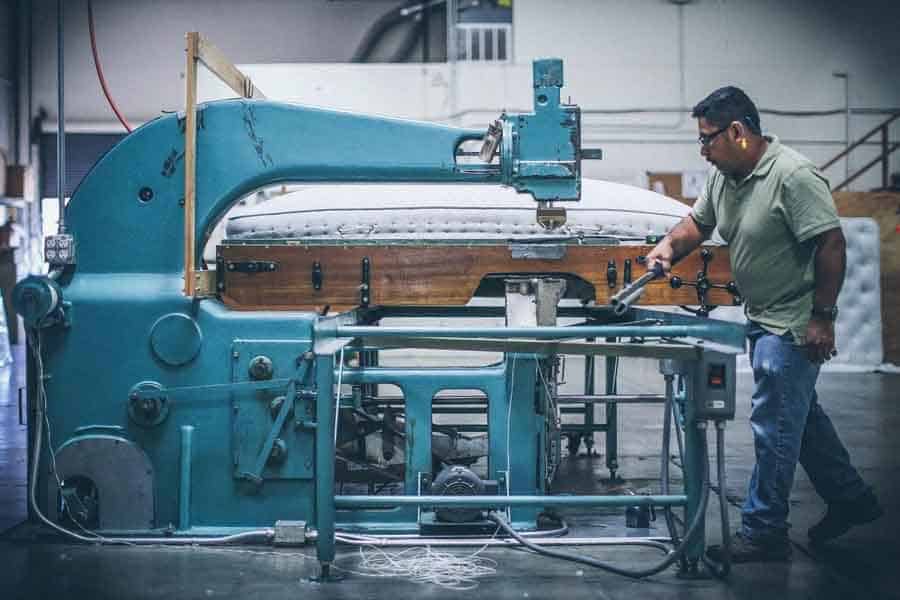
Made to last Miguel Molinero works with a mattress on one of McRoskey’s Mattress Co.’s tufting tables, a 1950s-era, cam-driven machine that the company bought used in 1992. San Francisco-based McRoskey has been in business for more than a century.
Rahmer also recommends that equipment be cleaned and inspected at regular intervals. “And when there is a problem, the operators need to call the engineers right away,” he says.
Newer equipment can be easier to maintain, “but there is a little truth in the old saying, ‘They don’t make ’em like they used to,’ ” Rahmer says. “I do find that some older equipment is really well made and lasts a long time. Newer equipment tends to be more user-friendly in terms of using it and taking care of it. It also can be challenging finding parts for older machines.”
Several machines on the McRoskey factory floor—including three United Mattress Machinery Co. lace tufters—date back to the 1950s. The company has coiling machines still in operation that are the same vintage or older.
“One thing that keeps these machines going is that they get regular cleanings and lubrication,” Rahmer says. “We don’t let our operators abuse the machines.”
Rahmer says sewing machines can be a particular challenge to maintain.
“Sewing machines can be very sensitive,” he says. “When I am adjusting or setting up a sewing machine, I ask the sewers to please not make further adjustments to the machine when I leave. Ten different people will adjust the same machine 10 different ways, so it is good practice not to have too many people involved.”
When it comes to breakdowns and downtime, Rahmer advises his engineers to be patient.
“Don’t rush the repair. If you don’t have time to fix it correctly the first time, you certainly don’t have to time to fix it twice,” he says. “And make the most of any downtime: If you have to wait a couple days for parts, what else can be addressed on that same machine while you are waiting?”
12 tips to keep equipment humming
1) Read the operator and technical manuals for all workstations and follow maintenance schedules. Conduct periodic inspections of all machinery.
2) Never use a machine for a function it wasn’t designed to perform. And never overload a machine. Stay within the manufacturer’s recommended parameters.
3) Offer continuous training for all maintenance staff and operators. “The more knowledgeable a person is, the less effort required to repair a problem,” says William Richey, vice president of customer service for Atlanta Attachment Co. in Lawrenceville, Georgia.
4) Provide staff with precision testing equipment and efficient tools.
5) Clean machines daily after each shift. Keep machines covered when not in use.
6) Oil machines daily or before each shift, using top-quality lubricants.
7) Know which parts are considered “consumable,” such as blades, power drive belts and sewing needles. “Keep several of those in stock so you don’t have to wait for replacements,” says Tommy Johnson, mechanical engineer and principal with D.R. Cash Inc. in Louisville, Kentucky. “Also, consider keeping a few nonconsumable, hard-to-find parts in stock.”
8) Buy quality parts. Don’t be fooled by cheaper copies.
9) Ensure blade systems are in good working order and tensioned properly. If the band knife is not tracked properly, the lives of the wheel, blade and guide will be shortened, and cutting accuracy will be lower. Also, wheels deteriorate over time, “so inspect them monthly and clean them periodically to maintain a proper crown and blade tracking,” says Rick Hungerford Jr., president of ESCO (Edge-Sweets Co.) in Grand Rapids, Michigan.
10) Keep an ample supply of clean air, which is critical for reliable pneumatic system performance and lifespan.
11) Listen for changes in the sound of machinery. Unusual noises are a likely indicator of machinery malfunction.
12) Respond promptly to service-related information and alerts displayed on computer control workstations when equipment is operating.





